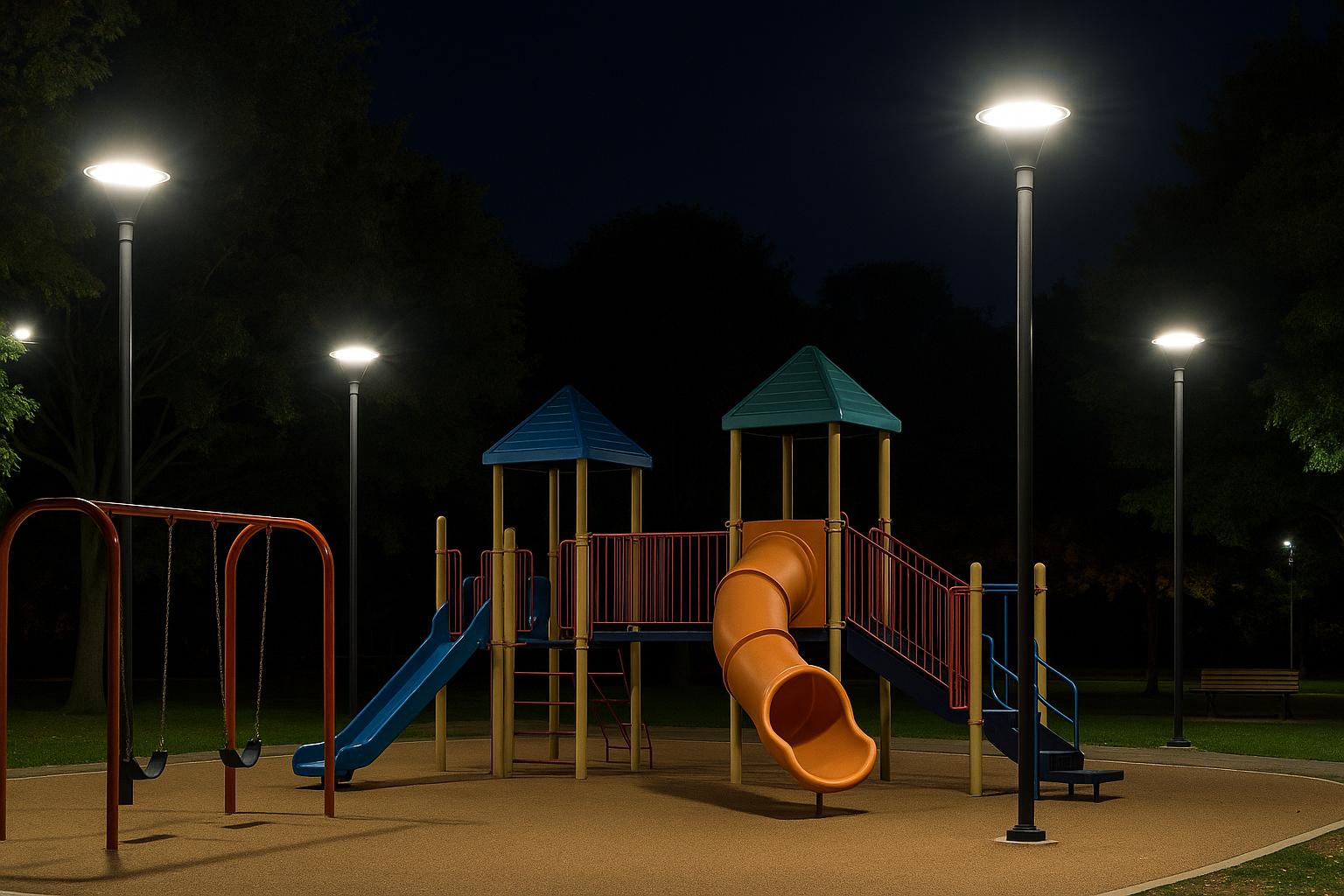Brightening Play Spaces: The Importance of Playground Lighting
Playgrounds are more than just recreational spaces. They are vital community assets that support child development, encourage outdoor activity, and provide a gathering spot for families and friends. While the importance of safe and engaging playground equipment is widely acknowledged, one often overlooked aspect is Playground Lighting.
As urban and suburban areas grow and evolve, ensuring that playgrounds remain accessible and safe into the evening hours has become increasingly important. Thoughtfully designed playground lighting plays a crucial role in safety, usability, and overall community well-being.
Why Playground Lighting Is a Necessity, Not a Luxury
Traditionally, playgrounds were viewed as daytime destinations. However, today’s lifestyles are shifting. Parents work late, school ends later, and children’s schedules are often packed with activities. With limited daylight during the fall and winter months, the need for proper playground lighting has never been more apparent.
Enhancing Safety and Visibility
One of the most important functions of playground lighting is to ensure safety. Poor visibility increases the risk of accidents. Children may trip on uneven surfaces, collide with others, or fail to see obstacles or play structures clearly in dim light. Parents and guardians also need sufficient light to supervise effectively.
Furthermore, proper lighting helps reduce crime and vandalism in public spaces. A well-lit playground is less likely to attract antisocial behavior, making the area safer for children and families during the evening and early morning hours.
Promoting Longer Use and Accessibility
By extending the usable hours of the playground, lighting encourages more consistent use of these community resources. In many neighborhoods, parents might not get home from work until the sun is already setting. A well-lit playground allows children and families to enjoy fresh air and physical activity even after sunset.
Increased accessibility also benefits shift workers and families with non-traditional schedules. Playground lighting ensures that these community members are not excluded from outdoor recreation due to time constraints.
Key Elements of Effective Playground Lighting
Designing effective playground lighting involves more than simply installing a few light poles. It requires a strategic approach that considers safety, aesthetics, energy consumption, and the surrounding environment.
Uniform Illumination
Even lighting across the entire play area is essential. Dark corners or harsh glare can cause discomfort or pose a hazard. Uniform lighting minimizes shadows and reduces the risk of children running into unseen objects or areas.
Durable and Weatherproof Fixtures
Outdoor lighting must be built to withstand the elements. Fixtures should be vandal-resistant, water-resistant, and durable enough to handle impacts from both weather and playground activity.
Energy-Efficient Solutions
Modern playground lighting often incorporates LED technology. LEDs are not only energy-efficient, but they also have a longer life span and require less maintenance. Solar-powered lights are another sustainable option, ideal for eco-conscious communities or areas without easy access to electricity.
Low Light Pollution
Lighting design should aim to reduce light pollution by using shields, filters, and directional lighting to focus illumination downward and away from homes or natural habitats. This not only benefits the environment but also respects the privacy of nearby residents.
Aesthetic and Community-Friendly Design
Good playground lighting does not just serve a practical function. It should also enhance the space’s overall ambiance. Warm lighting can create an inviting atmosphere, making the playground feel welcoming even after dusk.
Smart Playground Lighting: The Future of Urban Design
As cities become smarter and more connected, so do their public spaces. Intelligent playground lighting systems are now available, bringing innovation and convenience to community areas.
Motion-Sensor and Adaptive Lighting
Some lighting systems use motion sensors to activate or brighten when activity is detected. This saves energy and reduces unnecessary light when the playground is not in use. As soon as children or parents enter the space, the lights automatically adjust to provide safe visibility.
Remote Monitoring and Management
With smart systems, park officials or maintenance crews can monitor lighting remotely. They can adjust brightness or identify outages in real time. This leads to quicker repairs, lower maintenance costs, and a more reliable experience for users.
Integration with Other Smart Features
In some modern parks, playground lighting is integrated with surveillance cameras, public Wi-Fi, or emergency call stations. This enhances overall functionality and safety, providing more value to the community.
Designing for Inclusivity and Sensory Needs
In inclusive playground design, lighting must also consider children with sensory sensitivities or disabilities. Flickering, overly bright, or colored lighting can be overstimulating for some children, particularly those on the autism spectrum. Soft, diffused lighting that avoids sharp contrasts can help create a more calming and comfortable play environment.
Inclusive playground lighting means creating a space where all children feel welcome and safe, regardless of their abilities or sensory needs.
Community Benefits Beyond the Playground
Effective playground lighting offers benefits that extend beyond the playground itself. Well-lit parks encourage evening strolls, jogging, and dog walking, fostering a more active community. It also promotes a sense of pride and ownership in shared spaces, leading to better care and reduced vandalism.
Moreover, illuminated playgrounds can support community events, outdoor movie nights, or pop-up markets. These activities help enrich neighborhood life and bring residents together.
Practical Considerations for Implementation
Before installing playground lighting, communities should consider the following:
- Local regulations regarding public lighting and energy use
- Budget and funding, including grants for sustainable infrastructure
- Community input to ensure the lighting meets actual user needs
- Long-term maintenance plans to ensure reliability and safety
Public-private partnerships, green infrastructure grants, and local fundraising initiatives are all potential avenues to finance these upgrades.
Conclusion: A Bright Investment in Community Health
In today’s fast-paced and ever-changing world, outdoor play is more important than ever. Proper playground lighting ensures that children and families can safely enjoy public spaces at any time. It encourages physical activity, social connection, and mental well-being.
Whether in a bustling city center or a quiet neighborhood park, lighting is a small change that delivers significant benefits. It transforms playgrounds into 24-hour assets that are safe, welcoming, and ready for joy, regardless of the hour.
Investing in playground lighting is an investment in a brighter, healthier future for our communities. Let’s make sure our play spaces shine brightly, for everyone.













